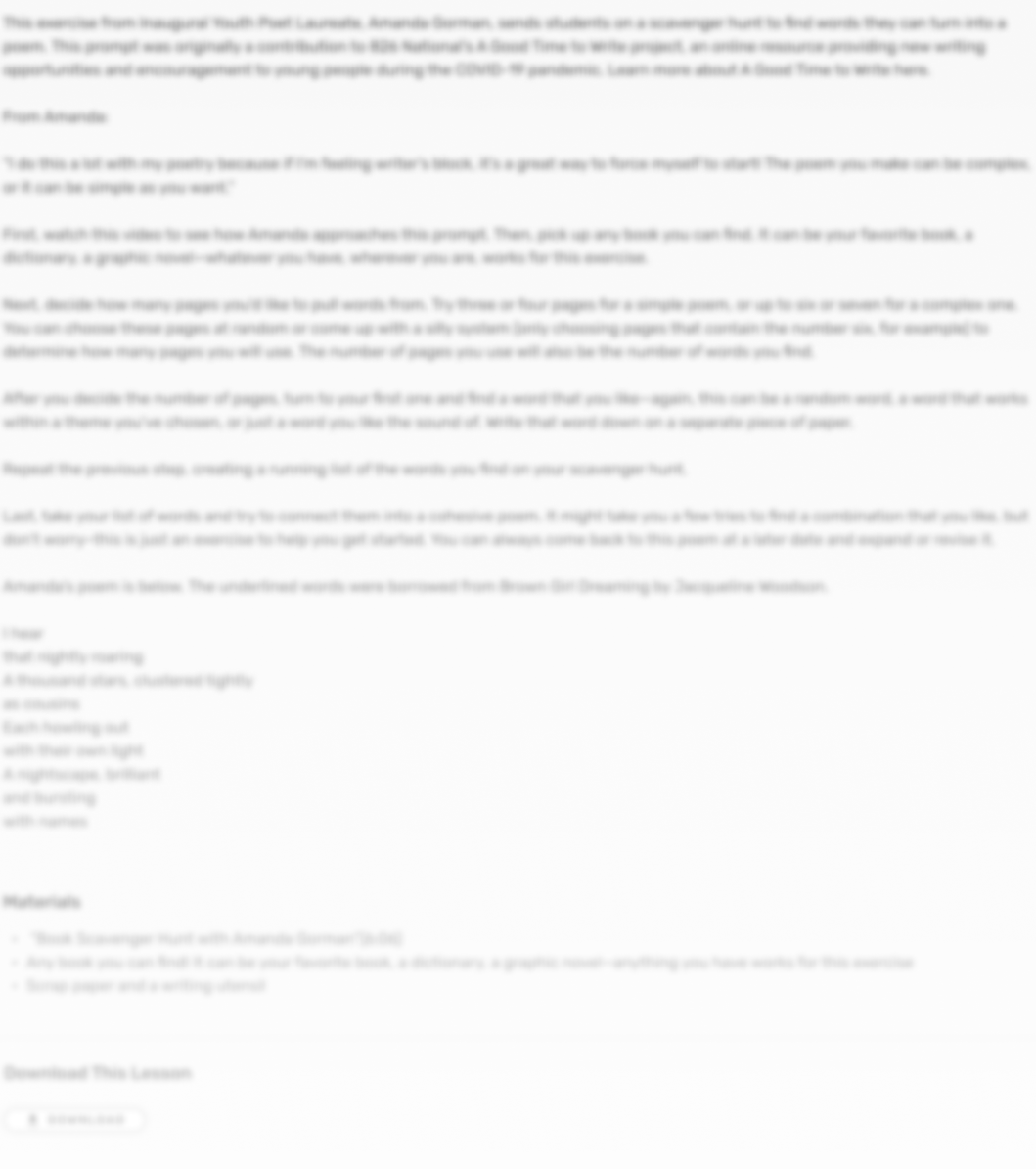 Grades 9–12
Grades 9–12 Narrative
Narrative Lessons
LessonsYour students will learn how to reconstruct classic tales through altering story elements, including: setting, point of view, and resolution.




Note to Educators: In this lesson, educators act as the head of a publishing house, giving students their next writing assignment. A planner, listing the deadlines for each step, is built-in to the letter. If you choose to complete this lesson with your students, we suggest you fill in these dates together as a class.
Dear Writers:
As your publisher, I have a new and exciting assignment for you. Our company has decided to take a new approach to children’s literature and we need your help. Fairy tales have been a literary staple for a very long time, but due to the change in popular reading recently, they have lost their appeal. That’s where you come in with your incredible writing skills. Your assignment is to choose an already published fairy tale and update it. The fairy tale can be from any civilization in the world, whichever fairy tale you choose is fine. Choosing the fairy tale is only the first part of the assignment. Once you choose which tale you want, you then have to decide
how to reconstruct it. You have three choices for reconstruction:
Setting: Change the location and time period of the fairy tale. Keep in mind that the basics of the story must remain the same, but changing the setting will change the way the characters speak and the clothes they wear as well as the world around them.
Perspective: Change who narrates the story. By changing the perspective from which the story is told, keep in mind that the basics of the story will still remain the same, but the manner in which the information is given will be altered a bit.
Resolution: Change the ending of the story. By changing the ending, you will have to alter some of the events slightly, but the general basics of the story should remain.
You will have time during the work day to spend on your assignment and there will be several deadlines that you must make sure to meet in order to have the finished product ready for publication on time.
Our publication date is __________ and the printing press is prepared to begin on that date so that the stories can be shipped to distributors. All stories must be submitted on that date or we will lose money in printing. In order to make the __________ publication deadline, I have set up a few smaller deadlines along the way to help you stay focused and on track. They are as follows:
Fairy Tale and Topic deadline: __________ (A form will be provided for you to list the fairy tale that you have chosen and which of the three choices you picked for the reconstruction)
First draft deadline: __________ (Your first draft should be written, typed, andsubmitted electronically to me by 5pm on this date)
Second draft deadline: ___________ (Your second draft should be typed and submittedelectronically to me by 5pm on this date)
Illustrations deadline: __________ (Your illustrations should be neat and colorful. They may be submitted either electronically or in a folder labeled with the name of the writer and illustrator. You have your choice of illustrator, but make sure that you meet with the illustrator early enough with a draft of your tale so they have time to prepare to meet this deadline)
Good luck and happy writing!
by Cristeta Boarini, 826 MSP
In this lesson, students explore the genres of historical and speculative fiction before they reimagine a time they felt powerless and write a different outcome.
by Cristeta Boarini, 826 MSP
Students will identify something they have inherited from their families, conduct interviews, and write a narrative essay. This lesson is especially well suited for English Language Learners.
by 826 National
Inspired by George Ella Lyon’s original poem, this lesson guides students through naming the people, places, and things that have shaped them.
by Rebecca Darugar, Liz Levine, and Brancey Mora, 826NYC and 826 National
Invite students to write about their personal experiences with social media and online platforms with this lesson from 826NYC.
by Rebecca Darugar, 826NYC
Students will work in a collaborative, constructive setting to create a vision for your classroom as a safe space for students and teachers.
by Aran Donovan, 826 New Orleans
Students (virtually) explore a local cemetery and write a monologue from a famous person buried there, including facts from their research and imagined details from a mapping exercise.
by 826 National
What happens when we start from a place of gratitude? In this lesson, students will use Ross Gay’s "Catalog of Unabashed Gratitude" as a catalyst for a daily gratitude journal.
by Molly Sprayregen, 826CHI
Over the course of this lesson, students produce memoirs, poems, and essays that explore what it means to be a member of the LGBTQIA community in America today.
by Katie Manning and Brandon Brown, 826LA
Students enter The Poetry Laboratory, no lab coats required, and use methods of observation and playful strategies to embark on the process of writing poetry.
by Debra Mitchell, 826CHI
Students will become script detectives, searching for the underlying structure of every play, and then use their own memories to inspire original plays.
by Stephanie Wykstra, 826NYC
A student’s guide for evaluating evidence and learning to spot misleading and false information.
by Klariza Alvaran, 826CHI
In this lesson, students explore the graphic novel genre with a focus on plot and character development, scripting dialogue, and visual composition.
by Summer Medina, 826NYC
Self-power comes from many places. In this Lesson, students will discover the power that comes from speaking and writing in multiple languages through poetry.
by Allie Mariano, 826 New Orleans
Students will tell stories about their neighborhoods and create maps that document change. The end result is a better understanding of a map’s ability to demonstrate the history behind fixed points.
by Tom Molanphy, 826 Valencia
Students will learn to see home in a fresh way, to walk through doors and open windows they never noticed, and to find the stories that home holds.
by Lisa Lutz, 826 Valencia
In this lesson by a young adult author and self-confessed superfan Lisa Lutz, students will learn letter-writing tips and create a fan letter.
by Ryan Harty, 826michigan
By examining patterns in engaging published stories and applying a set of meaningful prompts, students will learn how to develop well-rounded characters that readers really care about.
by Karla Brundage, 826 Valencia
In this Lesson, students will further their understanding of how language can impact identity through the process of naming.
by Saiya Miller, 826 New Orleans
Students will collect dirt, map their neighborhood, and listen to music that explores low sound, soil depth, and the psychological landscape of New Orleans.
by Ryan Harty, 826michigan
By examining patterns in engaging published stories and applying a set of meaningful prompts, students will learn how to develop well-rounded characters that readers really care about.
by Kyley Pulphus, 826 New Orleans
This lesson supports college-bound students in writing compelling personal statements. Students will go from blank page to finished draft as they brainstorm, develop, and analyze personal statements.
by Marya Spont-Lemus, 826CHI
Through brainstorming and drafting activities, students will learn the basics of personal narrative writing and craft an essay that they can use for college, scholarships, job applications and more.
by College Essay Guy and 826 National
This lesson from College Essay Guy introduces students to two types of effective college essay structures: Montage and Narrative.
by KQED Education
This lesson from KQED Education asks students to choose an issue they care about and create an editorial cartoon advocating for change on a local, national, or global level.
by 826 New Orleans
In this lesson, students have an opportunity to write a letter expressing their views on issues that matter to them most surrounding an election.
by Cristeta Boarini, 826MSP, and Skylar Burkhardt, 826 National
Few expressions of gratitude are more meaningful than a personalized letter. In this lesson, students reach out to essential workers and return their acts of service and kindness by giving thanks.
by Ola Faleti, 826CHI, with an introduction by Amanda Gorman, Inaugural Youth Poet Laureate of the U.S.
The pen is mightier than the sword. In this lesson, students learn there's no better evidence of this than the poetry behind social movements.
by Erin Ruane, 826 New Orleans
In this lesson, students are challenged to reevaluate the way water and land are represented on a map.
by Tim Campos, 826 New Orleans
Through discussion, map-making, and writing, students will investigate the ways in which our knowledge of places is constructed and will uncover the ways that this knowledge is distorted by biases.
by Kelly Jones, 826 New Orleans
Through writing, drawing, mapping, and researching a chosen fruit, students will become more familiar with the often complex history of food and how people access it.
by Dave Eggers, 826 Valencia
Over a flexible series of activities, students will learn to draw details from real life to create unforgettable characters and compelling stories.
by Dr. Anne Desrosiers and Precediha Dangerfield, 826 Valencia
The COVID-19 pandemic changed our lives. This lesson will support students in processing the changes in their everyday lives and help them to identify the creativity their community has exhibited.
by Gem Carmella, Ministry of Stories and BBC History
In this Lesson, students will learn how to write comedy sketches inspired by "Monty Python’s Flying Circus."
by Rebecca Darugar, 826NYC
Students examine relationships between art, poetry, politics, and current events, and reflect on personal experiences while writing social justice poetry.
by Daniel José Older, author of Flood City.
Students will work together to produce a newspaper for the fictional Flood City. In the process, they will take on the roles of editor and journalist to source, draft, and present their newspaper.
by Aarti Monteiro, 826NYC
Emotions play a big role in how we remember places important to us. Students explore this notion by writing memoirs, using plot, dialogue, and description to bring their stories to life.


We are thrilled to have you as the newest member of our online community. Stay up-to-date on the the latest and most relevant resources, student publication opportunities, and what’s new with the 826 Digital community.

